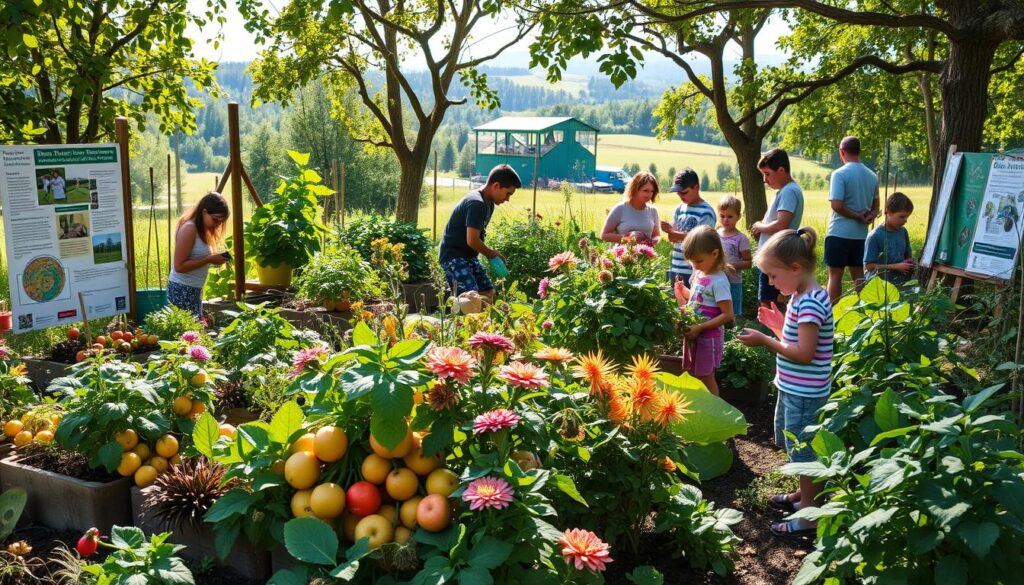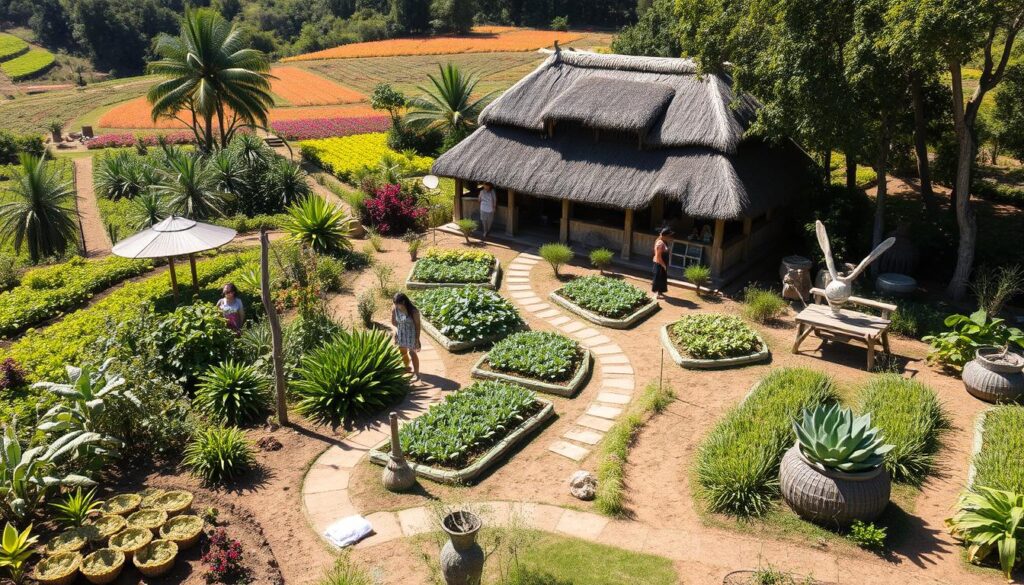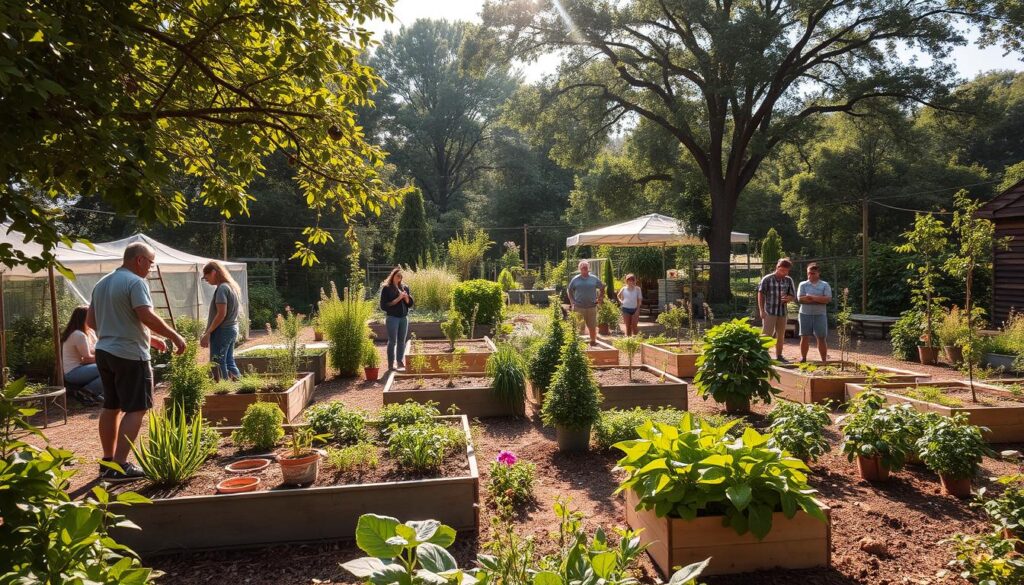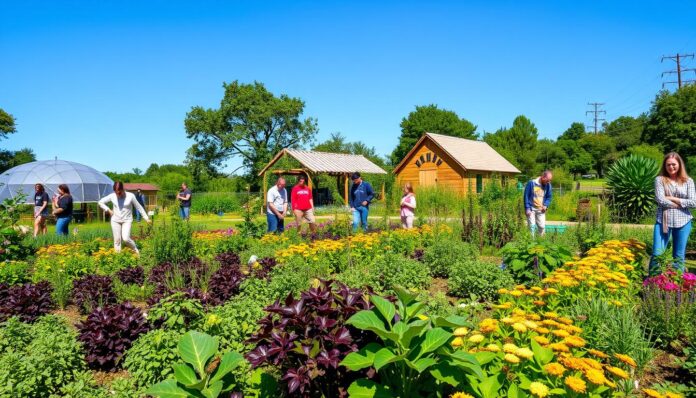The global ecotourism market is booming, valued at around $181.1 billion in 2020. It’s expected to grow by 14.3% from 2021 to 2028. This makes us wonder: can permaculture visitor education help promote sustainable agriculture and eco-friendly tourism? With 74% of travelers opting for eco-friendly stays, there’s a clear need for sustainable travel options.
Studies show that permaculture education boosts awareness by 90%. Educational programs based on permaculture principles see a 65% rise in students’ care for the environment. So, what advantages does permaculture visitor education offer to students, travelers, and local communities?
Key Takeaways
- The global ecotourism market is growing, with a value of around $181.1 billion in 2020.
- Permaculture visitor education can promote sustainable agriculture learning and eco-friendly tourism.
- Educational programs aligned with permaculture principles improve students’ environmental stewardship attitudes.
- Permaculture education leads to a 90% increase in awareness about sustainable practices among participants.
- Permaculture visitor education can benefit students, travelers, and local communities by promoting sustainable practices and eco-friendly tourism.
Introduction to Permaculture Visitor Education
Permaculture is a way to design sustainable systems. It’s key for teaching environmental care. People learn by doing, which helps them understand sustainable living better.
Definition of Permaculture
Permaculture is a method for designing ecosystems. It aims to meet human needs and fix damaged ecosystems. It combines animal care, building with nature, and fish farming, making it a broad field.
Importance of Visitor Education
Teaching visitors about permaculture is crucial. It helps people learn about caring for the environment. By doing hands-on activities, visitors see why permaculture is important for our planet.
Overview of Educational Programs
Permaculture education offers many learning chances. You can join workshops, apprenticeships, or guest programs. These teach about permaculture design, building with nature, and more.
For example, permaculture design courses are available. You can take them full-time or part-time, fitting your schedule.
The Role of Permaculture in Sustainable Tourism
Permaculture is key in sustainable tourism. It uses regenerative practices to lessen tourism’s harm. Tourists learn about nature and help local areas grow.
Being part of local life is a big part of permaculture tourism. Visitors get to know and help with green practices. This helps the planet and boosts local jobs.
Environmental Benefits
Permaculture aims for a system with no waste. It uses rainwater and solar power. It also builds with sustainable materials like straw bale.
Economic Impact on Local Communities
Buying local food and crafts cuts down on emissions. Workshops on green living can engage over 70% of guests. This supports local businesses.
Social and Cultural Engagement
Permaculture tourism, like the Green Circle Experience, boosts local economies. It enriches the visitor’s journey. It also preserves local cultures and nature.
Types of Educational Programs Available
Permaculture visitor education offers many programs for different learning styles and interests. These programs focus on sustainable agriculture and eco-friendly tourism. You can find workshops, guided tours, and online courses.
Workshops and hands-on training give you practical experience in permaculture. For example, the Permaculture Design Certificate program has 72 hours of workshops over four weekends. It covers topics like regenerative agriculture and soil management.
Guided tours and demonstrations let you dive into permaculture sites. You learn from experienced practitioners. Online courses and resources are flexible and accessible for those who can’t attend in-person.
These programs help grow eco-friendly tourism. They support sustainable agriculture learning and practices. Participants can positively impact the environment and local communities.
| Program Type | Description |
|---|---|
| Workshops | Hands-on training in permaculture design and implementation |
| Guided Tours | Immersive experience exploring working permaculture sites |
| Online Courses | Flexible and accessible learning resources |
Key Concepts in Permaculture Design
Permaculture design focuses on creating systems that are regenerative. It promotes holistic farming education and environmental stewardship programs. These principles help us design sustainable ecosystems that live in harmony with nature.
Through outdoor experiential education, people learn by doing. They discover the value of observing and working with nature. They also learn to use resources wisely and build regenerative systems. This hands-on approach strengthens our connection with nature and teaches us practical skills for living sustainably.

- Principles of permaculture, which guide the design of sustainable systems.
- Zones and sectors, which help in organizing and managing the design efficiently.
- Permaculture ethics, which emphasize care for the earth, care for people, and fair share of resources.
By using these concepts in holistic farming education and environmental stewardship programs, we can help build more sustainable communities. Outdoor experiential education plays a key role in making these changes happen.
Benefits of Participating in Permaculture Programs
Joining permaculture programs brings many advantages. You can learn new skills, meet new people, and have a better visit. These programs are all about regenerative tourism practices. They help make travel and community building more sustainable.
By taking part, you can pick up skills like permaculture design, organic farming, and natural building. This is a great way to grow personally and professionally.
Some key benefits include:
- Skill development: You can learn new skills, such as permaculture design, organic farming, and natural building.
- Networking opportunities: You can meet others who share your interests in permaculture.
- Enhancing visitor experience: You can dive into community immersion experiences and nature-based learning initiatives. This makes your visit more meaningful.
Being part of permaculture programs is a fulfilling experience. It offers many benefits for both individuals and communities. By joining in regenerative tourism practices and community immersion experiences, you help the environment and learn a lot.
Target Audience for Permaculture Education
Permaculture visitor education is for many people. This includes eco-conscious travelers, students, and teachers. It also includes community members and those who care about the environment. They all can learn from sustainable agriculture learning and eco-friendly tourism programs.
The people who can learn from permaculture education are different. They include:
- Eco-conscious travelers who want to learn green practices
- Students and teachers who are interested in sustainable agriculture learning and permaculture design
- Community members and stakeholders who can benefit from permaculture visitor education and eco-friendly tourism initiatives
Knowing who to teach permaculture to helps organizations make better programs. These programs can help people learn about sustainable agriculture learning and eco-friendly tourism.

Successful Examples of Permaculture Education Initiatives
Permaculture education has been a big success in teaching holistic farming and environmental care. The Permaculture Institute and the Land Institute are great examples. They teach about permaculture design and sustainable agriculture.
These programs offer hands-on learning outdoors. For example, the Permaculture Educators Program helps people become teachers worldwide. It also supports programs for youth and women in the global South and refugee camps.
Local farms also play a big role. They team up with farmers, educators, and community members. Together, they promote sustainable farming and care for the environment. These partnerships offer a chance to learn permaculture by doing it.
People like Rosemary Morrow have made a big impact in permaculture education. Morrow has taught in over 20 countries and won the 2017 Advancing Global Agriculture Award. She shows how to make permaculture work in different places, making it useful and relevant.
Incorporating Cultural Heritage into Programs
Regenerative tourism is more than just traveling sustainably. It’s about diving into local cultures through community immersion. By adding cultural heritage to permaculture programs, we offer unique learning experiences. These enrich both visitors and the local community.
Native plant landscapes teach us about biodiversity and indigenous management of the environment. This approach supports environmental conservation and keeps cultural knowledge alive.
Traditional Agricultural Practices
Traditional farming is key to cultural heritage in permaculture programs. Visitors learn about the local ecosystem and the community’s bond with the land. They discover regional food systems and their role in food security and sustainability.

Regional Food Systems
Regional food systems are crucial for community resilience. Supporting local food helps keep regional cuisines diverse. Permaculture programs offer workshops, farm visits, and community meals for educational and fun experiences.
| Aspect of Cultural Heritage | Benefits to Visitors | Benefits to Local Community |
|---|---|---|
| Native Plant Landscapes | Environmental education, cultural insight | Preservation of traditional knowledge, biodiversity conservation |
| Traditional Agricultural Practices | Hands-on learning, cultural immersion | Promotion of sustainable agriculture, community engagement |
| Regional Food Systems | Culinary education, community interaction | Support for local economy, preservation of regional cuisine |
Designing Effective Educational Content
Creating effective educational content for permaculture visitor education is key. It involves curriculum development that includes hands-on activities. This lets participants learn sustainable agriculture in a practical way. It also promotes eco-friendly tourism and helps visitors understand permaculture better.
A good curriculum covers various topics, like permaculture design and sustainable agriculture. It uses lectures, workshops, and hands-on activities for learning. For instance, a program might include a visit to a local organic farm. There, participants can see sustainable practices and permaculture in action.
Effective educational content includes:
- Hands-on learning activities, like designing a permaculture garden
- Engagement strategies, like group discussions and problem-solving
- Curriculum that uses real-world examples and case studies
By using these elements, permaculture education programs offer a comprehensive and engaging experience. They promote sustainable agriculture and eco-friendly tourism. Jen Mendez, an experienced educator, says, “Our programs focus on essential life skills, not just academic rigor. They emphasize holistic education.” This approach fosters a community of practice, where participants learn from each other and share experiences. It helps build a more sustainable future.
| Topic | Description |
|---|---|
| Permaculture Design Principles | Introduction to permaculture design principles and their application in sustainable agriculture |
| Sustainable Agriculture Practices | Overview of sustainable agriculture practices, including organic farming and agroforestry |
| Eco-Friendly Tourism | Discussion of eco-friendly tourism and its role in promoting sustainable agriculture and permaculture |
Marketing Permaculture Visitor Education
Marketing is key to promoting permaculture visitor education. Using digital tools like social media and email helps reach more people. Environmental stewardship programs are a big part of permaculture, showing the value of caring for our planet.
Working with tourism agencies can boost permaculture education. By teaming up with local tour groups, we can offer holistic farming education experiences. These include gardening, conservation work, and educational workshops.
Some top marketing tips for permaculture visitor education are:
- Use social media to promote and connect with people
- Work with local tourism agencies for special deals
- Focus on the benefits of outdoor experiential education and caring for the environment
By using these strategies, we can draw in a wide range of people. This helps spread the word about permaculture. It shows how important it is for holistic farming education and environmental stewardship programs.
| Marketing Strategy | Description |
|---|---|
| Social Media | Use social media to promote and connect with people |
| Collaboration with Tourism Agencies | Work with local tour operators for special deals |
| Highlighting Benefits | Focus on the benefits of outdoor education and caring for the environment |
Evaluating the Impact of Educational Programs
Regenerative tourism is becoming more popular. It’s key to check how educational programs affect community and nature. We need to see if these programs are working well. This helps us make them better for the community’s future.
We can use feedback to see how programs are doing. This can be through surveys or talking directly to people. This way, we can make the programs better for everyone involved.
When we look at educational programs, we should think about a few things. These include:
- How well people learn and remember
- How well community experiences work
- The effect on learning about nature
By looking at all these, we can make sure our programs are good for the community and the planet. This supports regenerative tourism and learning about nature.
The main goal is to make tourism better and more sustainable. We want to focus on community and nature. Together, we can make a better future for everyone.
| Program | Impact | Outcome |
|---|---|---|
| Community Immersion Experiences | Increased cultural awareness | Improved community relationships |
| Nature-Based Learning Initiatives | Enhanced environmental knowledge | Increased conservation efforts |
Challenges in Permaculture Education
Permaculture visitor education has many hurdles, like funding, resources, and awareness. These obstacles can make it hard to teach sustainable farming and eco-tourism well.
Some big challenges in permaculture education are:
- Funding and resources: Many programs have trouble getting enough money and resources. This makes it tough to offer top-notch education and training.
- Public awareness: It’s key to tell people why permaculture and sustainable farming are important. But, it’s not always easy.
- Ensuring accessibility: Education should be open to everyone, no matter where they live or their background.
Even with these challenges, permaculture education can still make a big difference. By tackling these issues and offering great education, we can help make a greener future.

Supporting permaculture education and sustainable farming helps eco-tourism grow. We need to tackle these challenges to make education more accessible and effective. This way, we can promote sustainable practices better.
| Challenge | Description |
|---|---|
| Funding and resources | Securing funding and resources to provide quality education and training |
| Public awareness | Raising public awareness about the importance of permaculture and sustainable agriculture |
| Ensuring accessibility | Providing accessible education and training to all, regardless of geographical location or socio-economic background |
Future Trends in Permaculture Visitor Education
As more people learn about sustainable living, permaculture education is changing. It now focuses on holistic farming education and environmental stewardship programs. Technology, like virtual reality, is being used to make learning more engaging.
Some key trends in permaculture visitor education include:
- Technology integration: Using digital tools to enhance the learning experience and provide access to a wider range of resources.
- Virtual reality experiences: Allowing visitors to immerse themselves in permaculture environments and gain a deeper understanding of sustainable living practices.
- Growing global interest: As more people become interested in sustainable living, permaculture visitor education is becoming increasingly popular, with a growing demand for outdoor experiential education programs.
The future of permaculture visitor education is promising. New trends and technologies keep coming. By combining holistic farming education, environmental stewardship programs, and outdoor experiential education, we can build a more sustainable world.
| Trend | Description |
|---|---|
| Technology Integration | Using digital tools to enhance the learning experience |
| Virtual Reality Experiences | Allowing visitors to immerse themselves in permaculture environments |
| Growing Global Interest | Increasing demand for permaculture visitor education programs |
Policy and Advocacy for Permaculture Education
Regenerative tourism practices are key for boosting permaculture education. They foster community involvement and learning from nature. A recent survey shows 69% of Americans believe in global warming, showing the need for green practices.
Government backing is vital for permaculture education. It offers funds and resources for learning programs. Non-profits also help by providing hands-on experiences and nature lessons. Grassroots efforts, like combining social justice with environmental causes, are crucial for change.
Some effective strategies for policy and advocacy include:
- Working with local governments on regenerative tourism
- Teaming up with non-profits for community experiences
- Supporting grassroots movements for nature learning
Together, we can advance permaculture education and build a greener future. Practices like permaculture gardening show how all parts of an ecosystem are connected.
| Strategy | Benefits |
|---|---|
| Regenerative tourism practices | Promotes community immersion experiences and nature-based learning initiatives |
| Government support | Provides funding and resources for educational programs |
| Grassroots movements | Essential for environmental advocacy and promoting nature-based learning initiatives |
Creating a Community of Practice
Permaculture visitor education is key in teaching sustainable agriculture and eco-friendly tourism. It brings people together to share knowledge and skills. This helps create a better future for all.
Networking and teamwork are crucial in a community of practice. People can learn from each other’s wins and losses. This way, they can find new ways to apply permaculture in their areas. Sustainable agriculture learning helps them gain the skills needed for eco-friendly systems.
Being part of a community of practice has many benefits. These include:
- Sharing success stories and best practices
- Developing new skills and knowledge through permaculture visitor education
- Building relationships and networks with like-minded individuals
- Supporting the development of eco-friendly tourism initiatives
By focusing on permaculture visitor education and sustainable agriculture, we help grow a global community. This community is all about making the future more sustainable.
| Community Aspect | Benefits |
|---|---|
| Networking | Sharing knowledge and skills |
| Collaboration | Developing new strategies and solutions |
| Sustainable Agriculture Learning | Developing skills and knowledge for eco-friendly systems |
Conclusion: The Future of Permaculture Visitor Education
Permaculture visitor education is on the rise, offering a bright future. It empowers people to care for the environment through hands-on learning. This approach is open to everyone, regardless of age or background.
Farmers markets are booming, showing more people want sustainable food. Projects like Food Forest Abundance have involved over 500 families. They’re learning to grow their own food using permaculture methods.
Permaculture can help us use less water and fight food insecurity. It also protects biodiversity and creates jobs, especially for those who need them most. By working together, we can make sustainable living common.
We have the power to create a better world through permaculture education. Let’s join this movement and help build a sustainable future for all.

